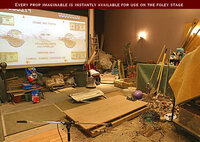 The post-production process known as "Foley" refers to the art of recording "live" sync sound effects to picture. It is akin to looping the dialogue, but instead of recording the actors performing their lines while watching themselves on screen -- skilled craftspeople known as "Foley artists" will walk, run, and act out any sync sound effects to match what the actor is seen (or implied) doing in the picture.
The post-production process known as "Foley" refers to the art of recording "live" sync sound effects to picture. It is akin to looping the dialogue, but instead of recording the actors performing their lines while watching themselves on screen -- skilled craftspeople known as "Foley artists" will walk, run, and act out any sync sound effects to match what the actor is seen (or implied) doing in the picture.
Back in the golden era of Hollywood cinema, this was done routinely for three reasons. First off, because the microphones deployed on those early sound stages lacked sensitivity, and were lucky enough to just pick up the loud dialogue of the actors on the set. And yes, in those days, the actors performed all of their lines in a robust "stage voice". Even the "whispers" could be heard across the room! As for the quieter sounds (sound effects) that the actors made, such as footsteps, guns cocking, pens scribbling, pages turning, and so forth -- the mics could barely pick them up from the distances above the actors' heads where the mics were positioned.
 From Sony Pictures Museum: A sample foley stage.
From Sony Pictures Museum: A sample foley stage.
Notice all the props within easy reach, and playback projection.
Secondly, due to the insensitivity of these early mics, or due to loud background noise -- the dialogue was often "looped" back at the studio. The looping or ADR process replaced the voices, but not the sound effects of the scene. So all of the sync sound effects had to be added to the soundtrack.
The third reason for Foley is somewhat related to the second, in that studios wanted to edit their films with foreign distribution in mind. If you dub an actor's voice from native English to anything else, then you will need to replace most of the sound effects as well. (at least any of them that were recorded simultaneously under the dialogue).
Adding Foley sound effects will add dimension and texture to your soundtrack. Sometimes, the sound itself becomes a critical part in the storytelling. For example, we see an actress hiding for her life in a closet. But we hear the footsteps and creaking floorboards of the intruder…
If you are a major studio, the process of Foley recording involves a specialized recording studio known as the Foley Stage. The Foley Stage includes some manner of projection (film or video), along with the ability to record audio in sync with the picture. The studio itself features acoustic wall panels that are hard surfaced on one side (so that "interior" scenes will have some "hardwalled edge" to the sound) as well as a non-reflective soft side (for echo free "exteriors"). The floor of the studio is divided up into a grid pattern of Foley pits.
Foley pits are small areas covered or filled with a particular "surface", so as to be able to simulate footsteps. Examples of Foley pits would include carpet, hardwood, marble, cement, loose wood planking, metal sheeting, ceramic tile, loose dirt, gravel, sand, and water.
In addition to the pits, Foley stages also contain an assortment of common props and hardware, including doors, latches, light switches, drawers, and a ton of miscellaneous "toys" for simulating any noises that appear onscreen.
All that is wonderful if you have a large production budget. But what can be done without renting an elaborate facility?
Let's break down what we need and how to achieve it.
